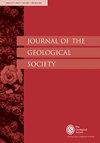斯堪的纳维亚Caledonides的Hølonda地区的中奥陶世地层和火山活动:Iapetus Laurentian边缘附近弧-大陆碰撞后的复杂构造岩浆发育
IF 3
3区 地球科学
Q2 GEOSCIENCES, MULTIDISCIPLINARY
引用次数: 0
摘要
斯堪的纳维亚-喀里多尼亚中部的Hølonda地区是喀里多尼亚造山带模型的关键,因为其具有劳伦系亲缘关系的奥陶纪动物群在北大西洋开放期间滞留在波罗的海一侧。在这里,我们提出了一个基于重映射、沉积学、火成岩地球化学、Nd和Sr同位素以及地质年代学的修订地层和构造岩浆模型。Hølonda群(约470–461 Ma)反映了从大陆架的陆上和浅海沉积到沿沉降斜坡的深水沉积的过渡。在约468 Ma的阿达基特岩和MORB型岩浆作用之后,在约467–465 Ma的benmoreitic–Rhythitic、shoshonitic、钙碱性和超碱性火山作用。复杂的岩浆作用发生在沿劳伦外侧微大陆的弧-大陆碰撞之后,与俯冲极性翻转和板块回滚有关。这导致了造山岩石圈增厚上一个宽阔盆地及其毗邻大陆架的裂谷作用和打开。相关地幔上升流和贫化和可变交代地幔的部分熔融发生在与地中海中部相当的构造岩浆环境中。Hølonda–Ilfjellet环境在喀里多尼亚-阿巴拉契亚造山带上是独特的,可能反映了与塔康尼-格兰扁造山带东北端劳伦大陆地体的相互作用。主题收藏:本文是Caledonian Wilson周期收藏的一部分,可在以下网站上获得:https://www.lyellcollection.org/topic/collections/the-caledonian-wilson-cycle补充材料:https://doi.org/10.6084/m9.figshare.c.6368922本文章由计算机程序翻译,如有差异,请以英文原文为准。
Mid-Ordovician stratigraphy and volcanism in the Hølonda area, Scandinavian Caledonides: complex tectonomagmatic development following arc–continent collision near the Laurentian margin of Iapetus
The Hølonda area of the central Scandinavian Caledonides is a key for models of the Caledonian orogen due to its Ordovician fauna of Laurentian affinity, now stranded on the Baltic side during opening of the North Atlantic. Here, we present a revised stratigraphic and tectonomagmatic model based on remapping, sedimentology, igneous geochemistry, Nd and Sr isotopes, and geochronology. The Hølonda Group (c. 470–461 Ma) reflects a transition from subaerial and shallow-marine deposition on a continental shelf, to deeper-water sedimentation along a subsiding slope. Adakitic and MORB-type magmatism at c. 468 Ma was succeeded by benmoreitic–rhyolitic, shoshonitic, calc-alkaline, and ultra-alkaline volcanism at c. 467–465 Ma. The complex magmatism followed arc–continent collision along a microcontinent outboard of Laurentia, associated with subduction polarity flip and slab rollback. This led to rifting and opening of a wide basin and its adjoining shelf on thickened orogenic lithosphere. Associated mantle upwelling and partial melting of depleted and variably metasomatized mantle occurred in a tectonomagmatic setting comparable to that of the central Mediterranean. The Hølonda–Ilfjellet setting is unique along the Caledonian–Appalachian orogen, possibly reflecting interaction with Laurentia-derived continental terranes at the northeastern end of the Taconian–Grampian orogenic tract.
Thematic collection:
This article is part of the Caledonian Wilson cycle collection available at:
https://www.lyellcollection.org/topic/collections/the-caledonian-wilson-cycle
Supplementary material:
https://doi.org/10.6084/m9.figshare.c.6368922
求助全文
通过发布文献求助,成功后即可免费获取论文全文。
去求助
来源期刊

Journal of the Geological Society
地学-地球科学综合
CiteScore
6.00
自引率
3.70%
发文量
68
审稿时长
6-12 weeks
期刊介绍:
Journal of the Geological Society (JGS) is owned and published by the Geological Society of London.
JGS publishes topical, high-quality recent research across the full range of Earth Sciences. Papers are interdisciplinary in nature and emphasize the development of an understanding of fundamental geological processes. Broad interest articles that refer to regional studies, but which extend beyond their geographical context are also welcomed.
Each year JGS presents the ‘JGS Early Career Award'' for papers published in the journal, which rewards the writing of well-written, exciting papers from early career geologists.
The journal publishes research and invited review articles, discussion papers and thematic sets.
 求助内容:
求助内容: 应助结果提醒方式:
应助结果提醒方式:


